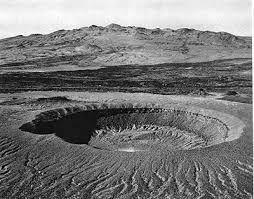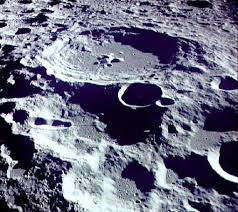Guiding Question: What are the factors that affect the appearance of impact craters? How do scientists use craters t tell the relative age of them?
Hypothesis: My hypothesis is that the depth of the crater will be bigger and bigger, the further distance a meteorite is thrown from. I think this because when the meteor is coming down to Earth from a larger distance, it has more inertia, and therefore it gows faster. In my opinion, if a meteroite goes faster, when it comes to the atmosphere it will burn more, creating more ejecta, and melting more ground when it hits the Earth. I am not sure how scientists tell the age of craters, but I am guessing that they can use the ejecta, to see how old it is, etc. They could also observe the crater itself and tell it's relative age by seeing how much of an erosion happened over time. As for the actual appearance of craters, I believe that the factors that can influence this are the heat of the meteroite hitting, as well as it's size, shape, and speed.

Materials:
What you need in order to successfully finish this lab are safety goggles, so that you do not damage your eyes from the flour, a tray, flour (you could also use soil or corn meal), noteboo to record your observations, a spoon, small marbles (if you want, you could conduct the lab with bigger marbles, as well), and Excel to make graphs of your results.
Data + Data Analysis:
Below you can find some of the data/information that me and my lab partners collected, as well as four graphs of the results.



Hypothesis: My hypothesis is that the depth of the crater will be bigger and bigger, the further distance a meteorite is thrown from. I think this because when the meteor is coming down to Earth from a larger distance, it has more inertia, and therefore it gows faster. In my opinion, if a meteroite goes faster, when it comes to the atmosphere it will burn more, creating more ejecta, and melting more ground when it hits the Earth. I am not sure how scientists tell the age of craters, but I am guessing that they can use the ejecta, to see how old it is, etc. They could also observe the crater itself and tell it's relative age by seeing how much of an erosion happened over time. As for the actual appearance of craters, I believe that the factors that can influence this are the heat of the meteroite hitting, as well as it's size, shape, and speed.

Materials:
What you need in order to successfully finish this lab are safety goggles, so that you do not damage your eyes from the flour, a tray, flour (you could also use soil or corn meal), noteboo to record your observations, a spoon, small marbles (if you want, you could conduct the lab with bigger marbles, as well), and Excel to make graphs of your results.
Data + Data Analysis:
Below you can find some of the data/information that me and my lab partners collected, as well as four graphs of the results.

Graphs...
The analysis of data:
I think that my hypothesis is partially correct with the data, but there are quite a few things that I didn't address in the hypothesis, that I will address now. In the data, I realize that the diameter doesn't change as drastically as the depth of the crater (it is always somewhere around 2 cntimeters). In my opinion, the diameter of a metroite will always be the same, no matter from which how far it has hit the Earth or moon. The distance doesn't change size of the meteorite. I think that in our case, the diameter got a bit larger every time, because of the ejecta around it, that made the diameter look larger. As for the depth of the crater, I think that I was correct, because, when the meteor is hitting the Earth, moon or any other planet in the universe from a large distance, it goes faster, because inertia has a greater impact on it. Therefore, when it comes down crashing with great speed, the depth of the crater, as well as the amount of matter melted will be larger.
Also, despite the depth becoming bigger, the amount of ejecta becoming larger as well, as the meteorite came from a bigger distance. That is because meteorite have a lot of impact on the surface of the planet they are hitting into, as they erode into it, and the matter that is eroded gets thrown all around the crater.
Conclusion:
In cocnlusion, I can say that there are several factors that affect the appearance of impact craters. One of them is speed. The faster the meteor is going, the bigger the damage on the planet it will cause. As I mentioned above this is because the further the meteor is coming from, the greater it's speed it. Speed is another factor that affects the appearance of craters. The faster the meteor is going, the deeper the crater will be, because the meteor will crash into the surface with more force. Shape of the meteor is also a factor that can influence the look of the crater. Depending on the shape, as well as the size of the meteor, the crater will be bigger or smaller, and the length as well as the shape of the ejecta will depend on those two factors. However, you must have noticed that most of the craters we see on the moon and as well as the Earth are round. This is because when the meteor goes through the atmosphere, it gets burned up, because of its massive speed, and it is mostly left falling to Earth in a rounded shape. This is also the reason why there are more craters on the moon then on Earth. Some craters that head to Earth are not quite big enough, and get burned up by our atmosphere. However, the moon has no atmosphere whatsoever, so any size meteors can hit it's surface.
Further Inquiry:
I think that this lab was quite straight forward, but still there was a few spaces where we could have potentially made an error. Firstly, as I mentioned above, we could have made an error when measuring the diameter of the crater, because of all the ejecta that was around it, the higher distance we threw the marble from. Also, we could have made a mistake by not being very accurate when throwing the marble from the distance we were supposed to. This would have made the lab/experiment unfair.
**As far as I know this is my last blog post in the school year of 2010/2011 for science, and I would really like to thank Mrs. M for teaching us so much this year, and I really feel that I have learned a lot. :)








No comments:
Post a Comment